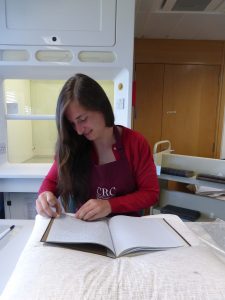In this blog, Project Conservator Mhairi Boyle her second day of in-situ book conservation training she has undertaken with Book Conservator Caroline Scharfenberg (ACR). Mhairi previously undertook a Maternity Cover contract at the CRC within the Conservation Department.
In the previous blog, the examination and initial steps in spine repair and board reattachment of two volumes from the Royal (Dick) School of Veterinary Studies (R(D)SVS) were described. The first blog in this series can be found here.
After my first session with Caroline, I sat down and pored over all my notes and the millions of photos I had taken. The amount of thought, precision and care that goes into book spine linings and repairs that will eventually be hidden and concealed shows how complex even in-situ book conservation steps can be. After jotting down my notes into a coherent order and cross-referencing everything with Caroline, I came back to the studio a few weeks later refreshed and ready for a full day of training and collaboration.
In this session, Caroline and I focused on making spine pieces and hollows, and examined how to reattach cracked book boards in different ways. One of the things I like most about working in Conservation is that we are constantly adapting and evolving techniques, tailoring them to the objects we are currently working on. This is exactly what Caroline demonstrated to me: informed by our initial examinations of both volumes, we tailored the treatment steps for each book based on its size, weight, and particular areas of weakness.

